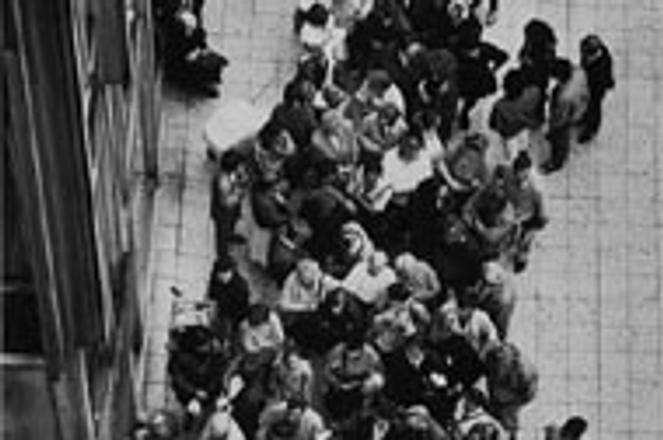"The majority of them don't know exactly what the RM-System really is. Many assume the RM-System is the entity that buys the bonds out."
Darina Huttová, RM-System press office
"I got here at half past eight and was already thirty-ninth in line."
Elderly woman, waiting at the RM-System
Citizens lining up at RM-S Bratislava.Ján Kuchta
At five o'clock in the morning on Monday, August 5, hundreds of Slovaks started lining up in front of RM-System offices all over the country hoping to trade bonds for instant cash. This was the day the National Property Fund (FNM) had set where bonds valued at 10,000 Sk issued by the government in bond privatization could be offered to trade on the RM-System.
The problem was that many of those who gathered in line thought that this meant they would receive money for their bond on this day. In fact many left dissappointed and confused learning that they were only offering their bonds to be sold until an FNM approved company could buy them though no one had bought any on the system yet.
The trading started at 10 a.m. Within one hour, bond offers exceeded potential demand by two and a half times. While over 15,000 citizens came to sell their bonds, the few entities granted a license by the FNM to buy the bonds - debtors to the agency from buying state-owned property mostly on credit - announced they would purchase a total of 6,033 bonds.
By Friday, the amount of people offering their bonds had increased to 40,000; however, not a single purchase order had been registered in the system, Darina Huttová from the RM-System press office told The Slovak Spectator. "The majority of them don't know exactly what the RM-System really is," Huttová said. "Many assume the RM-System is the entity that buys the bonds out."
RM-System employees had to explain to bondholders what they could do with their bonds. "The public was practically uninformed," Huttová said, adding that in May, the government decided to put the FNM in charge of educating bondholders on their options. "I guess it was too late," she added.
The RM-System is an alternative stock exchange for small shareholders designed before 1992 to enable coupon privatization to fairly distribute state-owned property back to Czechoslovak citizens after the collapse of Communism.
The coupon method continued under successive governments, culminating in 1994 when the interim Cabinet of then-Prime Minister Jozef Moravčík prepared the sell-off of 60 billion Sk of state-owned property to the 3.5 million Slovak citizens who owned coupon booklets and thus potential shares in the many companies in the then so-called second wave of privatization.
That all changed in June 1995 when Prime Minister Vladimír Mečiar, following advice from his economic advisers, cancelled coupon privatization and introduced FNM bonds in their place. Defending the change, Mečiar claimed coupon privatization was not fair to the citizens.
So in its place the government decided to exchange everyone's coupon booklet for a bond worth 10,000 Sk with maturity in 2001.
Trading with those bonds is strictly limited, as traders have to be licensed by the FNM and buyers approved by the agency. Most of the buyers will be those companies who owe the FNM money from receiving newly-privatized firms at significantly discounted prices. Now for example, instead of shelling out 800,000 Sk, a firm can pay back the same amount with 800 bonds. Sweetening the deal more, they will be able to purchase the bonds on the market for 600,000 Sk, traders said, though no less, since the government set the lowest purchase price at 7,500 Sk.
Confused citizens
Shortly after 1 p.m. on August 5, the crowd in front of an RM-System office on Miletičova ulica in Bratislava was still waiting patiently. "I got here at half past eight and was already thirty-ninth in line," an elderly woman said.
Most people were not giving up on the hope that they would get their money immediately. Whenever a client was leaving the RM-System office, those still in line would come alive: "So how much? When will you get the money?"
The answers, however, left people blue. "I don't know. They said I have to come back, or that I'll get a notice by mail," a disappointed pensioner explained on her way out the door. "Within 14 days at the least," she added.
According to Huttová, 80 percent of the bond sellers decided to offer them for 7,500 Sk. She agreed, though, that those trying to sell the bonds for more have practically no chance, as well as those who came to register their offer later.


